On Monday afternoon, May 20, 2013, an EF5 tornado, with peak winds estimated at 210 miles per hour (340 km/h), struck Moore, Oklahoma and adjacent areas, killing 24 people and injuring 377 others. The tornado was part of a larger storm that produced several other tornadoes during the previous two days. Another EF5 tornado occurred just 11 days later near El Reno, less than 30 miles (48 km) away.
The tornado of May 20 touched down west of Newcastle at 2:56 p.m. CDT, staying on the ground for 39 minutes over a 17 mile (27 km) path, crossing through a heavily populated section of Moore. The National Weather Service reported that the tornado was up to 1.3 miles (2.1 km) wide.

At the peak of the May 20 storm, more than 41,000 OG&E* customers were without power. However, within a few days, OG&E quickly reduced that number to approximately 5,000 customers, which included several thousand customers who suffered damages to the extent that they would not be able to accept power in the short term.
To restore power as quickly as possible, OG&E deployed nearly 1,000 company employees, contractors and crew members from neighboring utilities that worked around the clock to repair or replace nearly 1,000 damaged or destroyed structures. While power was restored quickly, additional outages were required to allow complete restoration of OG&E’s system.
In 2006, OG&E installed approximately 35 miles (56 km) of the ‘new’ ACCC Drake size composite core conductor on new steel monopoles to carry 138 kV current from the McClain power plant north towards Oklahoma City. The 140 foot (43 m) steel monopoles were approximately 122 feet (37 m) above ground level with an embedment into the ground of approximately 18 feet (5.5 m).
The path of the May 20 tornado crossed directly over the southernmost section of the 138 kV ACCC line just across the North Canadian River 0.9 miles (1.5 km) north of the power plant. Flying debris damaged the aluminum strands on the ACCC and ACSR conductors in several areas. Surprisingly, the ACCC conductor’s composite core was not damaged. This is especially remarkable considering one of the steel monopoles was hit by a large object (suspected to be a 40 foot shipping container that was on the opposite side of the road prior to the tornado).
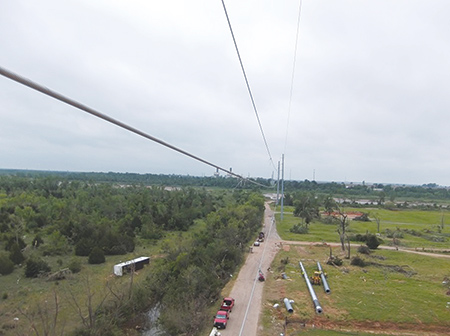
This photograph taken from the north looking south towards the power plant shows the location of the downed monopole after its removal and prior to its replacement. The shipping container on the left (east) side of the road was previously on the right (west) side of the road behind the steel monopole.
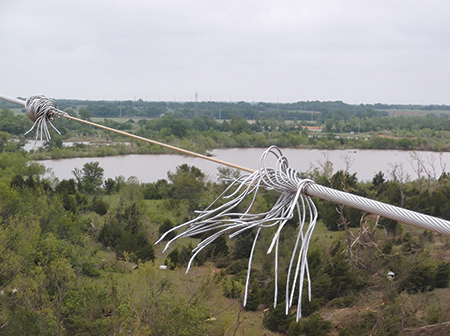
The impact to the steel monopole caused it to bend to an angle of approximately 45 degrees at ground level. The structure could have possibly been knocked completely to the ground if it had not been for the ACCC conductor’s strength. The load transferred to and through the conductor was actually enough to cause the two adjacent structures to also lean over in spite of their substantial embedment. While the force caused the aluminum strands to snap at one location on the ACCC conductor, surprisingly the high-strength composite core did not fail. The fact that the damaged conductor stayed in the air helped simplify and expedite repairs.
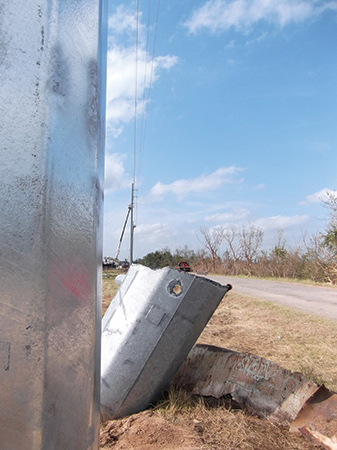
Newly installed replacement pole next to base of the damaged monopole.
Due to the damage to the aluminum strands on the ACCC conductor adjacent to the impacted monopole, a 30 foot (9 m) long section of new ACCC conductor was spliced in using 2 full-tension splices after the monopole was replaced. The manufacturer of the ACCC conductor, CTC Global, sent a field supervisor to the site to assist.
To accomplish the splicing in of a new section of ACCC conductor, the contractor gripped the conductor on either side of the damaged section with pocket book grips connected by a section of steel wire and a chain hoist. Tension was applied to the assembly to release tension on the damaged area of conductor. The damaged section was cut out and a new section of ACCC conductor was installed with two full tension splices. The tension on the chain hoist was released which completed the repair process.
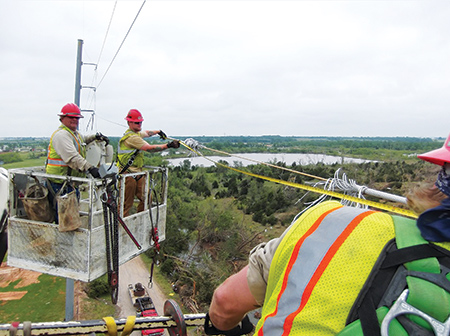
Crew measuring the damaged area of conductor in preparation for replacement.
Two other sections of ACCC conductor near this location were also replaced due to strand damage from flying debris. One section required splicing in a new 80 foot (24 m) piece of ACCC conductor using two full-tension splices and the same process as described above. The other section, of approximately 800 feet (244 m), used one splice and terminated at a dead-end. Repair sleeves or armor rods could have also been used over areas where the damage was relatively minimal, but there were so many areas in these sections, it was decided it would be better to simply replace them.
To replace the longer 800 foot (244 m) section, which was damaged but also not broken, the crew installed sheave wheels at the dead-end and tangent structures adjacent to the damaged conductor. A rope was used to pull the new ACCC conductor into position. This time, Chicago grips and a chain hoist was used to transfer tension from the undamaged section of ACCC to the new section. A full tension splice was then installed. At this point the damaged conductor was removed. The new ACCC conductor was pulled to tension and a ‘hard-side’ dead-end was installed. The new conductor was placed into the existing suspension clamps which completed the repair in this area.
Approximately one mile (1.6 km) to the northeast, a double circuit 138/345 kV lattice steel tower line experienced structural failure due to the impact of flying debris. This caused the double-bundled ACSR conductors to fall on the 138 kV ACCC line where it crossed under the tower line as well as adjacent ASCR distribution lines and two 138kV ACSR taps off of the tower line that went to the same power plant across the river. The ACCC conductor did not appear to be damaged, but after the 345 kV line was repaired, the areas of the ACCC conductor that were hit by the 345 kV line were covered with armor rod to reinforce potentially damaged strands.
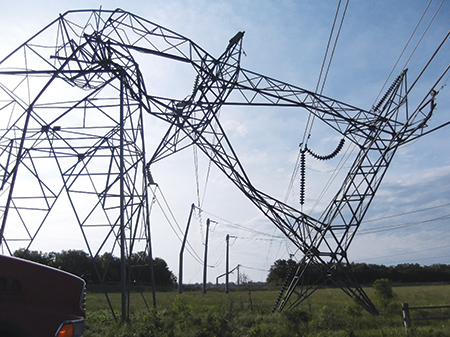
138/345kV lattice structure downed by flying debris.
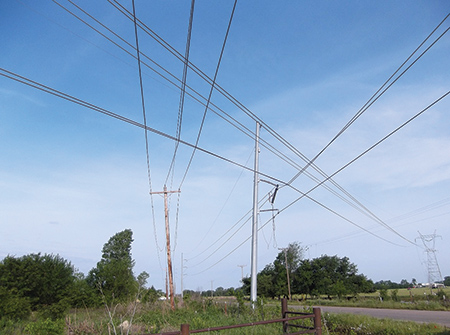
138/345kv conductors dropped on ACCC and adjacent distribution line. Note the force of the impact
was great enough to snap the upper phase insulator. The impact did not appear to damage the
ACCC conductor although armor rods were installed on the ACCC conductor as a precaution.
OG&E’s post-storm analysis indicated the design loading on the failed 138 kV ACCC monopole line was only about 60 percent or less, carrying only the one ACCC single conductor circuit. However, tornados are strange creatures. They will blow away a new brick home and leave a vacant crumbing wood frame house across the road unscathed.
The lattice towers, though designed in the 1960’s for 115 mph (185 km/h) winds, were probably loaded closer to the ultimate as they were double circuit 345/138 kV with bundled conductors on both circuits. In 2000, OG&E added the second bundle conductor to the lower 138 kV circuit which required some structural reinforcement. The design criteria for the 138 kV steel monopoles were 95 mph (153 km/h) with a 1.1 Safety Factor, which equates to a wind speed of about 105 mph (169 km/h).
Dan Morehead, Lead Transmission Engineer for OG&E, stated that overall, for the magnitude of damage from the May 20 and May 31 tornados, the damage to the transmission system was not as bad as he had anticipated. OG&E lost seven 345kV double circuit towers, five 345kV double circuit two-pole steel structures, ninety-seven single pole 138kV and 69kV Structures and ten H-Frames on May 20. Then, only 11 days later, on May 31, OG&E lost another ninety single pole structures and twenty-one H-Frames.
More detailed National Weather Service data received recently indicated that a wind speed of 111 to 135 mph (179 to 217 km/h) most likely occurred at the area where the ACCC conductor damage occurred and the steel monopole was hit. Considering that a shipping container flew from one side of the road to the other over a row of trees, most likely after impacting the steel monopole, the actual wind force may be underestimated to some degree.
At the 138/345 kV tower crossing, wind speeds were estimated at 136 to 165 mph (219 to 265 km/h). Just east of the tower line crossing, wind speeds of 166 to 200 mph (267 to 322 km/h) were estimated. However, most damage appeared to result from flying debris more than from the speed of the wind itself.
It appeared that some portion of a trailer house (including the wheel base or chassis) was thrown into the double circuit lattice structure. Dan Morehead also stated that one could possibly design for any level of extreme wind, but not necessarily design for such widely varying impacts such as flying buildings, trailers and farm vehicles.
While the adjacent steel reinforced ACSR conductors were damaged or destroyed by flying debris, the robustness of the ACCC conductor’s composite core was impressive. The fact that it didn’t break even when structures were knocked over allowed OG&E to make repairs as quickly as possible. As we work to build a more robust and efficient grid, new technologies will surely make our jobs easier.
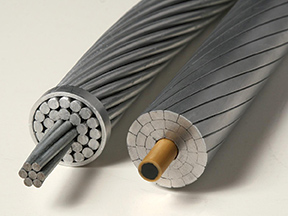
Conventional ACSR steel reinforced conductor (left)
next to an ACCC composite core conductor (right)
About the Author
 Dave Bryant, Director Technology, CTC Global was one of the original developers of the ACCC conductor and ancillary hardware components. His background in composite materials, testing and industrial design helped expedite the commercialization of the ACCC conductor.
Dave Bryant, Director Technology, CTC Global was one of the original developers of the ACCC conductor and ancillary hardware components. His background in composite materials, testing and industrial design helped expedite the commercialization of the ACCC conductor.
*OG&E serves more than 800,000 retail customers in Oklahoma and western Arkansas, and a number of wholesale customers throughout the region. OG&E, with about 6,800 megawatts of capacity, generates electricity from natural gas, western coal, and wind. OG&E’s electric transmission and distribution systems span 30,000 square miles.









